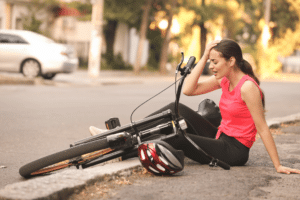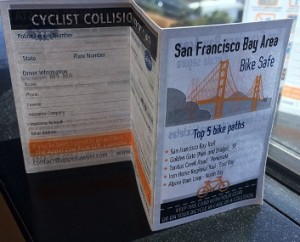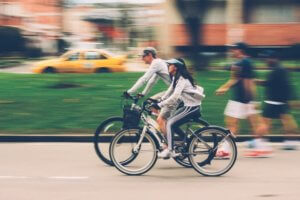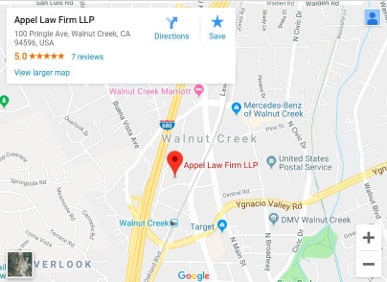 Bicyclists are some of the most vulnerable persons on our roads, and are involved in an inordinate number of injuries and fatal accidents every year. Most of these accidents can be blamed on motorist error or negligence, and lack of a safe biking environment. Our Walnut Creek law firm has 60+ years of combined experience handling bicycle accident cases throughout Contra Costa and Alameda Counties.
Bicyclists are some of the most vulnerable persons on our roads, and are involved in an inordinate number of injuries and fatal accidents every year. Most of these accidents can be blamed on motorist error or negligence, and lack of a safe biking environment. Our Walnut Creek law firm has 60+ years of combined experience handling bicycle accident cases throughout Contra Costa and Alameda Counties.
Bicycling Accidents in Walnut Creek
Bicycling has been heavily promoted as a mode of transportation, and as a result, there has been an increase in the number of bicyclists on our roads. However, this increase in the number of bicyclists has not been met with a corresponding enhancement in bicycling infrastructure and safely precautions. In California, the existing bicycle infrastructure, including bike lanes, is often woefully inadequate. This places bicyclists at harm because they’re frequently in close, potentially deadly, contact with motorists. These problems are quite prevalent in the San Francisco East Bay. Notably, Contra Costa County became the most dangerous county for bicyclists in Northern California last year according to the Bay Citizen.
Common Causes and Injuries in Bicycle Accidents
Most bicycle accidents are caused because motorists fail to yield right-of-way to persons on bicycles. Other causes include motorist unawareness and speeding. Sometimes a road hazard may also cause or contribute to an accident.
Often a bicyclist may have only their helmet to protect them from injuries in an accident, and is therefore at risk of serious injuries during a collision with a vehicle. Typically, a bicyclist involved in an accident with a car, truck, or bus may suffer from spinal cord injuries, brain injuries, fractures, road rash, lacerations and other injuries.
Important California Bicycle Laws
- Pedestrian Right of Way – In a marked crosswalk or unmarked crosswalk bicycle riders and drivers are required to yield to pedestrians.
- Stop Behind the Crosswalk – Make sure to leave crosswalks clear for pedestrians and remember to stop behind the line.
- Stay on the Street – No one over 16 years of age may ride on sidewalks except where signs are posted allowing bicycles.
- Ride With Traffic Flow – Remember to bike the same direction as traffic. Walk your bike on the sidewalk if you find yourself on the wrong block of a one-way street.
- Act Like a Auto Driver – Stop at stop signs and obey red lights, just like all other vehicles.
- Use a Light at Night – Reflectors and a front white light are required by law. We recommend you use a rear light as well.
- Use of the Lane When Necessary – If you’re riding next to parked cars, or there are other hazards in the bike lane, such as fixed or moving objects, vehicles, bicycles, pedestrians, animals, surface hazards, or substandard width lanes use the main lane to feel safer.
- Permitted to leave the Bike Lane – If you feel safer outside the bike lane, you can ride in other lanes of vehicle traffic.
Important Skills for Bike Safety in Walnut Creek
The California Bicycle Coalition describes several key skills you need to develop to ride safely. By mastering these essential skills, you can significantly reduce your risk for injury.
Stay Alert
Staying alert is critical for observing the signs that a collision might occur and taking actions to avoid the danger area. To respond to potential hazards, you’ll need to be able to turn your bike or stop quickly when a motorist makes an error or is distracted.
Clues that a collision is about to occur include a vehicle turning into your path as you go through an intersection or passing you on the left and turning to the right in front of you. In addition, a car door opening in your path can cause a serious accident.
Handling your bike properly is also critical for avoiding a collision. Make sure you can balance well and get on and off your bike easily.
Be Visible
It’s important to make yourself as visible as possible to drivers so they can avoid mistakes that can hurt or kill you. On roads with bike lanes, California state law requires that you ride in the bike lane in the same direction as traffic if you are traveling slower than other traffic. If you’re moving as fast as vehicles, you can leave the bike lane to avoid debris, parked vehicles and other hazards.
When bike lane is not available and you’re traveling more slowly than other traffic, you should ride in the right lane outside the reach of opening car doors. Move out into the lane if you’re traveling as fast as other traffic or you need to do so for better visibility. If you need to turn or stop, be sure to use hand signals.
Always follow the rules of the road, including obeying any signage, traffic signals and markings on roads. If you need to ride on a sidewalk, such as in a residential area, watch your speed and get ready to yield to vehicles at intersections and driveways.
Protect You and Your Bike
Keeping your bike in good mechanical shape and using the right bike safety equipment also play critical roles in maximizing your well-being when you ride.
The most vital piece of equipment you can use is a helmet that fits you properly. Your helmet should cover the back of your head and your forehead. Plan to replace your helmet every five years and after any fall; an impact can reduce the integrity of the helmet and put you at greater risk should you experience another accident.
Under state law, your bike must have at least one brake. In addition, a white light that can be seen at least 300 feet ahead of you and a red rear light visible from 500 feet are required if you ride at night. Your shoes, ankles or pedals also must have reflectors.
To keep your bike in good working order, remember to check essential functions before each ride. Inflate tires and test your brakes. In addition, make sure chains are properly seated, quick-release levers securing seatpost and wheels are sufficiently tight, and no items are loose on your bike.
Bike Safe Report Card
In 2012 (the most recent year figures were available), there were an average of 2 bicyclist deaths a day, nationwide. While accounting for just 2% of traffic fatalities, bikes are only used for 1% of trips – meaning that those who do cycle should be aware of the dangers. The number of non-fatal car vs. bike accidents is, of course, much, much higher, running about 50,000 every year. These are officially reported injuries, and the actual number may be double or triple that amount.
With this in mind, we’ve helped create the Bike Safe Report Card – a trifold pamphlet cyclists can carry around for use when an accident happens. The brochure style makes it small enough to tuck away in a backpack or even under a bicycle seat. The purpose is two-fold.
First, the Bike Safe Report Card gives basic information on traffic rules in graphical form. It makes a handy reminder for cyclists and can help educate drivers as well. Non-cyclists are often unaware of their obligations when it comes to sharing the road. Second, there is a section for recording information after an accident has occurred.
Understandably, a cyclist may be too upset to think clearly when a driver opens a door or cuts them off. It’s tough to keep calm amidst the rush of adrenaline and anger. This can even conceal injuries – we simply don’t notice the severity. Some may even be more concerned about damage to an expensive bike than damage to themselves. When this happens, it’s often the next day or later that the real extent of an injury emerges. Scrapes can get infected, or a “twisted ankle” turns out to be a fracture instead. Bruises appear you didn’t even know you had, or the “stiff neck” doesn’t go away.
Cyclist Collision Card of San Francisco, California

The California bicycle accident lawyers at the Appel Law Firm LLP represent persons who have been injured in bicycle accidents across California.

